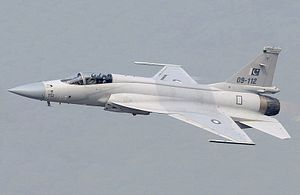The last batch of three Pakistan Aeronautical Complex/Chengdu Aerospace Corporation (PAC/CAC) JF-17 “Thunder” Block II multirole fighter aircraft will be handed over to the Pakistan Air Force (PAF) next month, according to media reports.
The PAF is expected to receive the remaining three JF-17 Block II aircraft at the end of June, Jane’s Defense Weekly reports.
“The aircraft are part of an order placed by the PAF in late 2017 for an additional 12 platforms that are currently on the Aircraft Manufacturing Factory (AMF) final assembly line at PAC Kamra,” the report reads. “AMF has built more than 100 JF-17s since the first JF-17 (serialled 09-111) was rolled out in November 2009.”
PAC has produced 50 Block I aircraft and 62 Block II JF-17s to date including the 12 Block II jets ordered in 2017. The PAF has currently 85 JF-17 Block I and II operationally deployed.
According to PAF Air Chief Marshal Mujahid Anwar Khan, production of the first batch of JF-17 Block III aircraft is expected to begin later in 2019, Jane’s reported on May 15. Notably, the chief designer of the JF-17 fighter jet, Yang Wei, stated in March that production of the aircraft has already begun.
However, this most likely only pertained to the Chinese-manufactured components of the aircraft such as the JF-17’s airframe with PAC reportedly producing 58 percent and CAC 42 percent of it. As I explained earlier this year:
All three JF-17 variants are powered by a Chinese license-built Klimov RD-93 (an RD-33 derivative) turbofan engine. The JF-17 has an approximate combat radius of up to 1,200 kilometers without refueling and can reach a maximum speed of up to Mach 1.6.
The JF-17 costs $25 million per unit, although the Block III per-unit price is expected to go up as a result of the new subsystems, including the expensive new AESA radar system. The PAF intends to procure up to 50 new Block III aircraft.
The aircraft can alternatively be armed with air-to-air, air-to-surface, and anti-ship missiles. It will also be able to fire beyond-visual-range air-to-air missiles (BVRAAM). An unnamed BVRAAM was test fired by the PAF [in February] and possibly [in March].
F-17 Block III aircraft will reportedly be fitted with a new electronic warfare system, upgraded avionics including a three-axis fly-by-wire digital flight control system, a helmet-mounted display and sight system, and Pakistan’s first Chinese-made active electronically scanned array (AESA) radar system.
The PAF “will make a decision on one of the two new Chinese AESA radars we are currently evaluating for these aircraft,” the PAF air chief was quoted as saying by Jane’s. The two radar models under evaluation are the Nanjing Research Institute of Electronics Technology’s KLJ-7A radar and the Leihua Electronic Technology Research Institute’s (LETRI) LKF601E. The new AESA radar system is expected to be installed on JF-17 Block III aircraft by 2020.
































